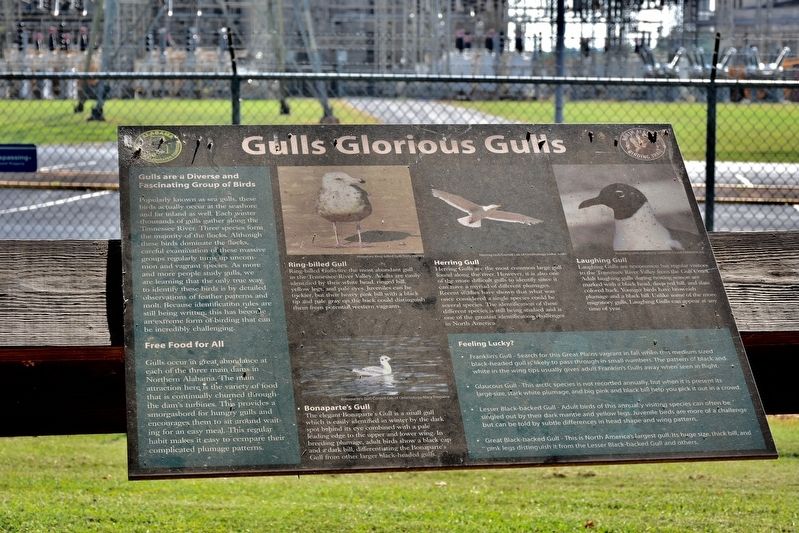Gulls Glorious Gulls
Gulls are a Diverse and Fascinating Group of Birds
Popularly known as sea gulls, these birds actually occur at the seashore and far inland as well. Each winter thousands of gulls gather along the Tennessee River. Three species form the majority of the flocks. Although these birds dominate the flocks, careful examination of these massive groups regularly turns up uncommon and vagrant species. As more and more people study gulls, we are learning that the only true way to identify these birds is by detailed observations of feathers patterns and molt. Because identification rules are still being written, this has become an extreme form of birding that can be incredibly challenging.
Free Food for All
Gulls occur in great abundance at each of the three main dams in Northern Alabama. The main attraction here is the variety of food that is continually churned through the dam’s turbines. This provides a smorgasbord for hungry gulls and encourages them to sit around waiting for an easy meal. This regular habit makes it easy to compare their complicated plumage patterns.
Ring-billed Gull
Ring-billed Gulls are the most abundant gull in the Tennessee River Valley. Adults are easily identified by their white head, ringed bill, yellow legs and pale eyes. Juveniles can be trickier, but their heavy
Herring Gull
e
Herring Gull are the most common large gull found along the river. However, it is also on of the most difficult gulls to identify since it can have a myriad of different plumages. Recent studies have shown that what was once considered a single species could be several species. The identification of these different species is still being studied and is one of the greatest identification challenge, in North America.
Laughing Gull
Laughing Gull are uncommon but regular visitors to the Tennessee Valley from the Gulf coast. Adult laughing gulls during nesting season are marked with a black head, deep red bill, and slate colored back. Younger birds have brownish plumage and a black bill. Unlike some of the male migratory gulls, Laughing Gulls can appear at any time of the year.
Bonaparte's Gull
The elegant Bonaparte's Gull is a small gull which is easily identified in winter the dark spot behind its eye combined with pale leading edge to the upper and lower wing. In breeding plumage, adult birds how a black cap and dark bill, differentiating the Bonaparte Gull from other larger black headed gulls.
Feeling Lucky?
• Franklin’s Gull Search for this Great Plains vagrant in fall when this medium
• Glaucous Gull - This arctic species is not recorded annually, but when it is present its large size, stark white plumage, and big pink and black bill help you pick it out in a crowd.
• Lesser Black-backed Gull - Adult birds of this annually visiting species can often be singled out by their dark mantle and yellow legs. Juvenile birds are more of a challenge but can be told by subtle differences in head shaped and wing pattern.
• Great Black-backed Gull - This is North American's largest gull. Its hugh size, thick bill, and pink legs distinguish it from the Lesser Black-backed Gull and others.
Topics. This historical marker is listed in these topic lists: Animals • Environment.
Location. 34° 47.584′ N, 87° 37.578′ W. Marker is in Muscle Shoals, Alabama, in Colbert County. Marker is on Reservation Road. Marker is located TVA's Wilson Dam Bird site #6 near TVA Power Station at Kiosk. Touch for map. Marker is in this post office area: Muscle Shoals AL 35661, United States of America. Touch for directions.
Other nearby markers. At least 8 other markers are within walking distance of this marker. Explore the River (here, next to this marker); Birds of North Alabama (here, next to this marker); Wilson Dam: Cornerstone of the TVA System
Also see . . .
1. Ring-billed Gull. Habitat Ring-billed Gulls often congregate around humans, at garbage dumps, parking lots, and freshly plowed fields. While the species is common on coastal beaches, particularly during winter, many Ring-billed Gulls lead inland lives, never setting eyes on the sea. (Submitted on July 27, 2017, by Sandra Hughes Tidwell of Killen, Alabama, USA.)
2. Herring Gull. Habitat Look for Herring Gulls in winter along coasts and near large reservoirs, lakes, and major rivers. They feed in habitats as diverse as open water, mudflats, plowed fields, and garbage dumps, and gather in almost any open space near food. In summer, they’re most likely to be seen along the Atlantic Coast, Great Lakes, and coastal Alaska; they also breed across the boreal far north. (Submitted on July 27, 2017, by Sandra Hughes Tidwell of Killen, Alabama, USA.)
3. Laughing Gull. Habitat Laughing Gulls are a coastal species and are only occasionally seen very far inland. Look for them in plowed fields, garbage dumps, parking lots, and shorelines. They nest, often in large numbers, on islands near the shore but safely isolated from terrestrial predators. (Submitted on July 27, 2017, by Sandra Hughes Tidwell of Killen, Alabama, USA.)
4. Bonaparte's Gull. Adult Description Small gull. White triangle in outer part of wing. Back pale gray. Underparts white. Head black during breeding. Dark spot behind eyes in winter. Immature Description Juvenile with much brown on head, neck, and back, a dark bar across the wing, and a black tail tip. Immature similar to nonbreeding adult, but with brownish black bar across the base of the wing, much black in the outer wing, and a black band across the tip of the tail. In first breeding plumage the black head is partly mottled with white. (Submitted on July 27, 2017, by Sandra Hughes Tidwell of Killen, Alabama, USA.)
5. Glaucous Gull. Adult Description Large gull. Head and underparts white. Back light gray. Wingtips white. Bill yellow with red spot near tip of lower mandible. Immature Description Juvenal Plumage: Body and head uniformly colored light brownish gray or buff. Whitish on chin and around base of bill. Dusky around eyes. Pale brown streaks on head. Back pale buff, with pale brown wavy bars. Rump barred brownish. Tail plain pale buff with highly variable pattern of whitish and darker brown bars. Bill pink with black tip. Legs pale flesh-colored. Eyes dark brown. (Submitted on July 27, 2017, by Sandra Hughes Tidwell of Killen, Alabama, USA.)
6. Lesser Black-backed Gull. Common across Europe, the Lesser Black-backed Gull is an uncommon, but regular visitor to eastern North America. Its occurrence on this continent increased dramatically over the last third of the 20th century. (Submitted on July 27, 2017, by Sandra Hughes Tidwell of Killen, Alabama, USA.)
7. Great Black-backed Gull. Habitat Great Black-backed Gulls live along the Atlantic Coast and inland on the Great Lakes. They choose isolated, predator-free sites such as piers or islands for breeding, and then disperse away from the colony for the rest of the year to feed at sea, along coasts, and at landfills. (Submitted on July 27, 2017, by Sandra Hughes Tidwell of Killen, Alabama, USA.)
Credits. This page was last revised on May 6, 2018. It was originally submitted on July 27, 2017, by Sandra Hughes Tidwell of Killen, Alabama, USA. This page has been viewed 298 times since then and 21 times this year. Photos: 1, 2. submitted on July 27, 2017, by Sandra Hughes Tidwell of Killen, Alabama, USA. • Bill Pfingsten was the editor who published this page.

